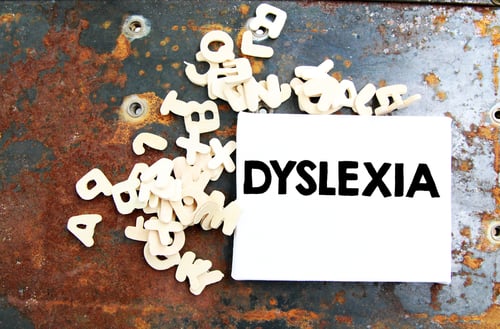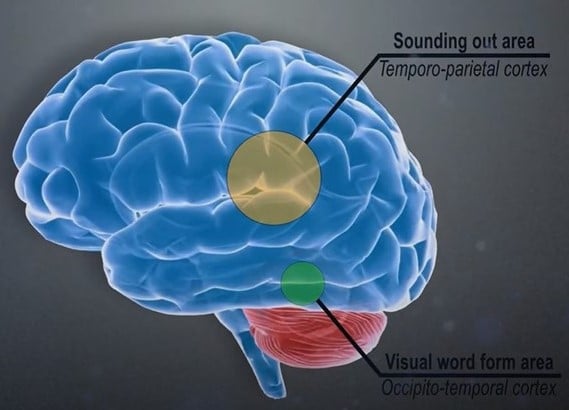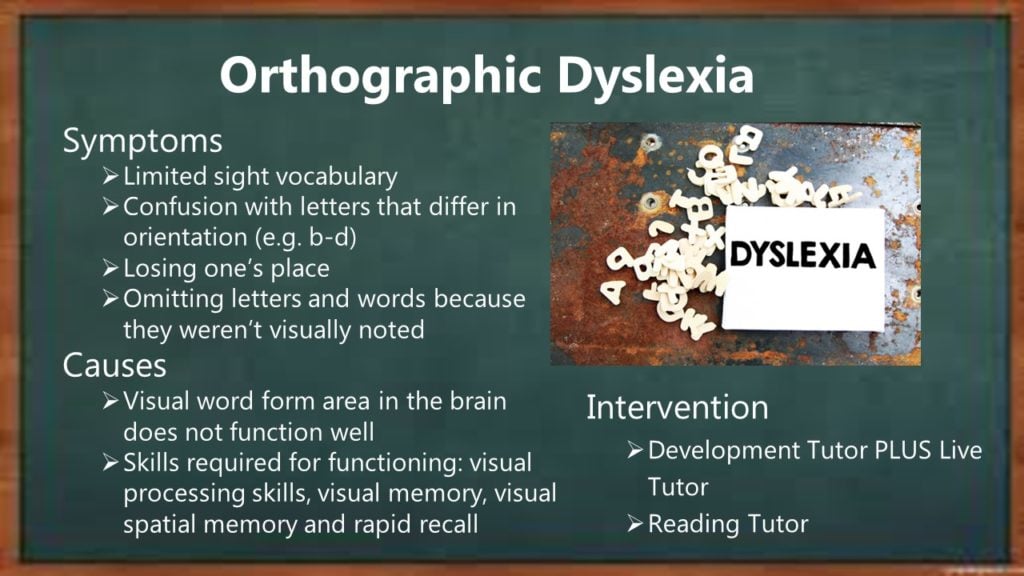
Good day Sue
My son’s phonological awareness is average, yet he reads painfully slowly. I would like information about your approach and how it supports children with more of an orthographic type of dyslexia.
Phillipa
.
.
Dear Phillipa
Before answering your questions, and for the benefit of other readers, I will first explain what orthographic dyslexia is. Orthographic dyslexia is a subtype of dyslexia that refers to children who struggle with reading because they cannot recognize words by sight. Synonyms are surface dyslexia and dyseidetic dyslexia.
Reading by sight is an important skill for a couple of reasons. One is that some words have tricky spellings. For example, words like one, said, whose, and people cannot be sounded out — readers need to memorize them. The other reason has to do with reading fluency. To read quickly and accurately, kids need to recognize many common words at a glance — without sounding them out.
Symptoms of orthographic dyslexia
The most common symptom of orthographic dyslexia is, thus, a limited sight vocabulary. Few words are instantly recognized from their whole configuration — they need to be sounded out laboriously, as though being seen for the first time. Children with orthographic dyslexia will also have difficulty learning irregular words that cannot be sounded out.
Other reading and spelling patterns associated with orthographic dyslexia include:
- Confusion with letters that differ in orientation (b-d, p-q) or words that can be dynamically reversed (was-saw).
- Losing one’s place because one does not instantly recognize what had already been read.
- Omitting letters and words because they were not visually noted.
- Difficulty recalling the shape of a letter when writing.
- Spells phonetically but not bizarrely (laf-laugh; bisnis-business).
- Can spell difficult phonetic words but not simple irregular words.
.
Most problems can only be solved if one knows what causes the problem. For example, a disease such as scurvy claimed the lives of thousands of seamen during long sea voyages. However, the disease was cured fairly quickly once the cause was discovered, viz., a Vitamin C deficiency.
Therefore, a viable point of departure would be to ask, “What is the cause(s) of dyslexia?” In your son’s case, one would like to be more specific and ask, “What is the cause(s) of orthographic dyslexia?”
Causes of orthographic dyslexia
Two separate brain regions are involved in reading: one in sounding out words and the other in seeing words as pictures — which is what sight reading is all about.
Glezer et al. (2016) concluded that skilled readers recognize words at lightning-fast speed when reading because the words have been placed in a sort of visual dictionary. This part of the brain is known as the visual word form area (VWFA) and functions separately from an area that processes the sounds of written words.

Glezer and her coauthors tested word recognition in 27 volunteers in two different experiments using fMRI. They could see that words that were different but sounded the same — like ‘hare’ and ‘hair’ — activate different neurons, akin to accessing different entries in a dictionary’s catalog. If the sounds of the word influenced this part of the brain, we would expect to see that they activate the same or similar neurons, but this was not the case — ‘hair’ and ‘hare’ looked just as different as ‘hair’ and ‘soup.’
Also, the researchers found a different distinct region sensitive to sounds, where ‘hair’ and ‘hare’ did look the same. The researchers thus showed that the brain has areas that specialize in doing each of the components of reading: one region is doing the visual piece, and the other is doing the sound piece. The part of the brain that does not work well in the case of a child with orthographic dyslexia is most likely the region that is doing the visual piece, i.e., the VWFA.
In the most extensive study of its kind up to date, Brem et al. (2020) confirmed that the VWFA is key to fluent reading. Pedago et al. (2011) supported the VWFA’s crucial role in the discrimination of letter orientation, which links to the well-known fact that a deficit in discriminating between a b and a d is a common symptom of orthographic dyslexia.
Activating the VWFA
Although some causes of dyslexia have a genetic origin (Kere, 2014) and environmental factors play an important role (Stein, 2018), cognition mediates brain-behavior relationships. Therefore, it offers a sufficient level of explanation for developing interventions. Thus, we must understand the cognitive difficulties that underpin reading failure, regardless of whether their origin is constitutional or environmental (Elliott & Grigorenko, 2014).
To intervene when a child struggles with orthographic dyslexia, we thus need to focus on the cognitive skills that must be acquired before one can become good at recognizing words by sight.
While phonological processing skills and auditory memory are foundational to learning phonics, visual processing skills such as spatial relations and form discrimination, visual memory, and visual-spatial memory are foundational to sight-reading.
Students with orthographic dyslexia may also struggle with rapid recall. Rapid recall refers to the speed with which the names of symbols (letters, numbers, colors, or pictured objects) can be retrieved from long-term memory (De Jong & van der Leij, 2003). This process is often termed rapid automatized naming (RAN), and people with dyslexia usually score poorer on RAN assessments than typical readers (Elliott & Grigorenko, 2014).
Intervention for orthographic dyslexia
The good news is that weaknesses in cognitive skills can be attacked head-on; it is possible to strengthen these mental skills through training and practice.
Edublox’s Development Tutor aims to strengthen underlying cognitive skills, including visual processing, visual memory, visual-spatial memory, and rapid recall.
In addition, a child with orthographic dyslexia will also need application in the form of reading and spelling exercises, which can best be accomplished through Edublox’s live tutoring services. Our live tutoring program is based on the proven Orton Gillingham approach but simultaneously aims to develop the brain’s visual word form area, mentioned above.
Watch this playlist and experience how Edublox training and tutoring help turn dyslexia around.
Key takeaways

Regards
Sue
More about Sue
Sue is an educational specialist in learning problems and dyslexia and has a B.A. Honors in Psychology and B.D. degree. Early in her professional career, Sue was instrumental in training over 3,000 teachers and tutors, providing them with the foundational and practical understanding to facilitate cognitive development among children who struggle to read and write. With over 30 years of research to her name, Sue conceptualized the Edublox teaching and learning methods that have helped thousands of children who were struggling to read, learn and achieve. In 2007, she opened the first Edublox reading and learning clinic, and now there are 30 Edublox clinics internationally. Her proudest moments are when she sees a child who had severe learning difficulties come top of their class after one or two years at Edublox. Sue always takes time to collect the ‘hero’ stories of students whose self-esteem is lifted as their marks improve.


